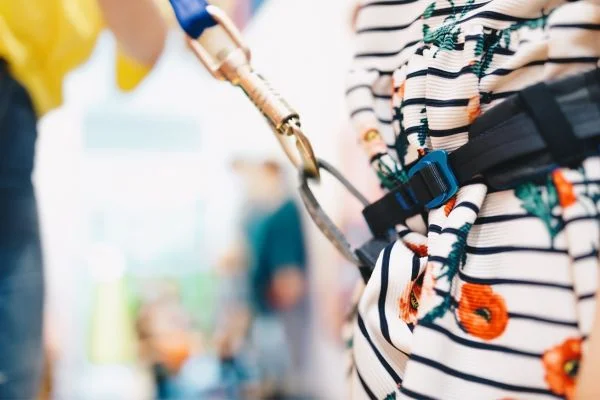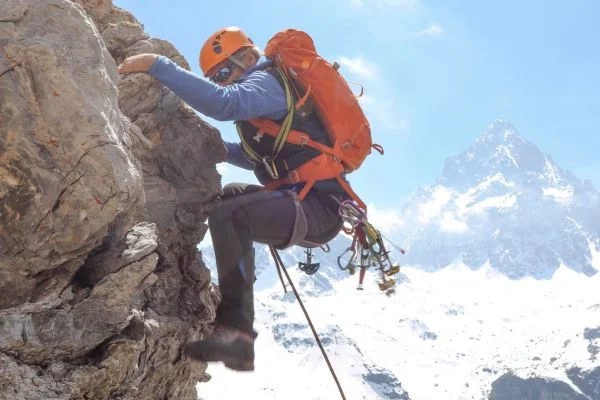If you are a climber, you know the importance of having quality carabiners. But how do you know how much weight your carabiner can handle? Understanding the strength and limitations of your carabiner is essential to staying safe while climbing. So let’s take a closer look at how much weight can a climbing carabiner hold to make sure you select the right ones for your next climb.
How Much Weight Can a Climbing Carabiner Hold | Strength Ratings
Carabiners are rated based on their strength in kilonewtons (kN). A kN is equal to about 225 pounds of force. Carabiners have three ratings: central axis, minor axis, and open gate. The central axis rating is the most important one, showing the force the carabiner can withstand when loaded along its long axis.
Generally, most strong carabiners have a significant axis rating between 22-27 kN or 4,950-6,050 lbs of force. Remember that these ratings only apply to new and unused carabiners. If your carabiner is worn or damaged, it will not be able to handle as much weight as it should.
The minor axis rating shows how much weight your carabiner can hold when loaded across its short axis. For example, most strong aluminum carabiners will have a minor axis rating between 7-12 kN or 1,575-2,710 lbs of force.
Lastly, the open gate rating shows how much weight a carabiner can hold when it is not connected to anything else. This number should always be lower than the major and minor axis ratings since it does not involve any other components. Aluminum carabiners typically have an open gate rating between 8-10 kN or 1,800-2,250 lbs of force. It’s important to note that all three ratings depend on each other. If one decreases significantly due to wear or damage, all three will also decrease. Hope so, now you know how much weight can a climbing carabiner hold.
How Strong Is a Climbing Carabiner?
Climbing carabiners are essential pieces of equipment for any climber. They come in various shapes and sizes. It can provide the strength and security needed to keep you safe while climbing. But just how strong are they? Let’s explore what makes carabiners unique and why they have become indispensable tools for climbers of all levels.

Rating Systems for Carabiners
You can rate carabiners by three numbers that refer to their strength: central axis, minor axis, and open gate. The central axis rating refers to the force. You can apply it along the long axis of the carabiner before it fails. In contrast, the minor axis rating refers to the force that you can apply along the shorter axis before failure. Finally, the open gate rating refers to the force applied to the gate when it opens before it fails. These ratings range from 10-45 kN (kilonewtons), depending on the size, shape, and material used in construction.
Strength vs. Weight
When choosing a carabiner, there is often a trade-off between strength and weight. Generally, stronger carabiners tend to weigh more than lighter ones – but this isn’t always true. Many lightweight carabiners offer surprisingly high levels of strength while remaining light enough to make them easy to carry around on your climbing adventures. Therefore, it’s essential to make sure you choose a carabiner that offers both adequate strength and weight for your needs.
Safety Standards
It’s essential to remember that all climbing gear should meet specific safety standards to ensure its reliability and durability. To ensure this happens, most countries have adopted international standards for climbing gear. Such as UIAA or CE certification, which test each product against various criteria. It includes strength testing. This means that when you buy a certified product, you know it has been tested for quality assurance. So, you can trust it will perform as expected when put under pressure during your climb!
Getting the Most Out of Your Climbing Carabiner: Tips for Safety and Smooth Climbs
So, the first step is picking the right carabiner. Look at the different types available – there’s the screwgate, auto-locking, and wiregate carabiner. Each has its strengths. Just make sure the design matches what you’re up to.
Inspect for Wear and Damage:
Give your carabiner a good once-over before you start. Look for cracks, sharp edges, or anything that seems off. If you spot anything, skip that carabiner – your safety’s more important.
Properly Attach to Gear:
This is like connecting the dots. Make sure you attach the carabiner right onto your gear. Follow the instructions from the folks who made it. Close and lock that gate, and double-check – better safe than sorry.
Gate Orientation Matters:
Keep an eye on how the gate’s facing when you attach it. Point it away from where it might bump into stuff. Especially watch out for rocky encounters.
Master the Opening Technique:
Practice opening the gate with one hand. Get a feel for it – whether it’s a twisty one or it pops open. You’ll be a one-handed pro in no time.
Avoid Cross-Loading:
Imagine wearing your backpack sideways. Not comfy, right? Same goes for carabiners – make sure the way the load sits lines up with the carabiner’s strongest part.
Use the Right Knots:
Tie your rope onto the carabiner with the right knots. You’ve got the figure-eight and the clove hitch, among others. They’re like the glue that holds everything together.
Prevent Rope Drag:
Rope drag’s like your clingy friend – it slows you down. Hook up carabiners smartly to keep your rope from getting stuck on all those twists and turns.
Regularly Check Gate Closure:
Give the gate a glance now and then. It’s like checking your shoelaces – you don’t want any surprises. Make sure it’s shut tight, even if the climb’s giving you a bumpy ride.
Clean and Lubricate:
Keep that carabiner clean and happy. Dirt can gum up the works. Give it a wipe-down and maybe a bit of lube if it’s that kind of carabiner. Smooth is the name of the game.
Proper Storage:
When you’re done, find a comfy spot for your carabiner. Dry and cool is what it likes. Keep it away from wet and sun – they’re not its best friends.
Retire When Necessary:
Carabiners aren’t immortal. They wear out over time. If you notice it’s seen better days, it’s time to part ways and get a fresh one. Safety’s your top priority.
Conclusion:
When selecting climbing gear for your next climb, make sure that to know how much weight your gear handle. This includes making sure that all your chosen carabiners have good strength ratings. The central axis rating will tell you how much load capacity your chosen gear has along its long axis. It should generally be between 22-27 kN or 4,950-6,050 lbs of force. Keep in mind that these numbers may decrease due to wear and tear over time so inspect them before using again! In addition to checking out the central axis rating, the minor axis and open gatherings typically range from 7-12 kN or 1,575-2,710 lbs. Ultimately understanding how much weight can a climbing carabiner hold. You can make an informed decision about which gear is right for your climbing needs!

